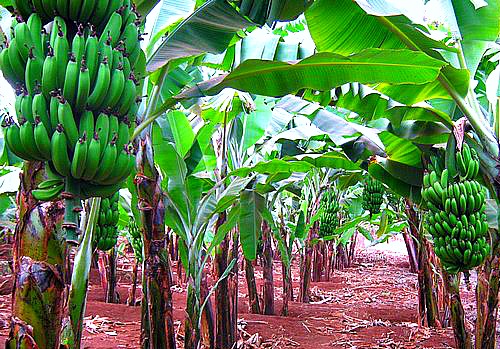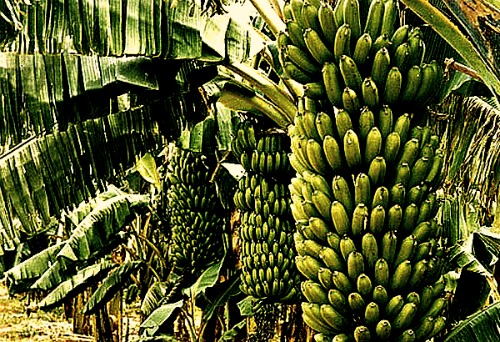VANILLA BEANS | SOYBEAN OIL | SOYMEAL & CAKE | COCOA BEANS | COFFEE BEANS
How to Grow Bananas in Uganda
Are you planning to start commercial banana growing in Uganda? Just looking to start a small banana plantation in your backyard and are looking around the internet for tips and ideas? ... Or your looking online to buy bananas/banana suckers for planting your Matooke?
 Banana Plantation in Uganda
Banana Plantation in UgandaWhatever your banana growing quest is in Africa, please take time to read through this Uganda plant guide for answers; We answer common questions that any succefful banana grower in Africa should ask.
We discuss how you can grow one of Uganda's favorite traditional foods....!
You also have the chance to buy bananas, Banana suckers, and other banana farm inputs online.
Scientifically bananas are classified in the Family; musacae, with genera; ensete and musa. Bananas are perennial herbs and grow up to 5m or more. Banana is one of the major food security crops in Uganda as the crop supplies food to people almost all the time. Aside of food, bananas in Africa are used to produce local brew, and these crops also supplement animal feed.
In this Uganda Banana Plant guide you will find information about:
- The different Varieties of Matooke/Banana/Plaintain in East Africa
- Which environmental factors you require to grow Banana/Matooke/Plantains
- What materials you will need to plant/propagate Bananas
- When and How to plant your bananas in the ground
- How to manage you banana plantation
- How best to harvest your bananas
- Practical take home Tips for successfully growing Plantains/Matooke
- Where to Buy bananas/seedlings/Suckers/farm supplies online
You also can also ask the plant guide any question about banana growing in Africa.
Banana varieties in East Africa
We have three main groups of banana plants in East Africa:
The East African Highland Banana: these are the most dominant in the region especially in Uganda. They include the cooking type (Matooke) and the brewing type (Mbidde) and these two types are physically similar.
The plantains: (e.g. Gonja) these are mostly grown in the high lands of kasese in Uganda, the crop is not widely grown and is eaten roasted.
The cultivars of the East African coast: these include the edible Sukalindizi dessert banana eaten ripe, kisubi a brewing type, kayinja also a brewing type and kivuvu a cooking and brewing type.
Environmental factors you will need to grow Bananas
You will need the appropriate climate, the right soils and your land should be well prepared.
Agro Climate; Banana grows best at a temperature of about 27°C. The grow bananas and flowering are negatively affected at lower temperatures. Banana grows best when they receive 1500-2500mm rain per year which is well distributed over the year. The crop grows best where relative humidity is at least over 60%.
Soil requirements; Banana requires a deep, well drained loam soil with high humus content. Banana best grows in soil pH ranging from about 5.6-7.5. It doesn’t tolerate acidic soil. The crop needs an adequate supply of potassium, nitrogen, magnesium, calcium and phosphorus.
Land preparation: land should be slashed and prepared without burning to protect organic matter. About two ploughings are sufficient to provide a good seed bed for banana. The drainage channels or soil conservation bunds are established along the contours.
What to plant when you want to grow bananas in Africa
You can propagate/Plant your Bananas vegetatively or by breeding. The vegetative method however is the commonest among our farmers, and you will be able to use any of these planting materials below:
Peepers; these are very young suckers appearing above the ground with scale leaves only.
Sword suckers; these are formed from buds or eyes low on corm and bear narrow elongated leaves, these are usually 30_60 cm tall with. These are the most preferred material as they are usually firm in the ground.
Maiden sucker; these are relatively old with greater than 60cm and when are used for propagation it’s advised that the leaves should be cut off to try minimize water loss.
Bits of large corms; they are obtained from corms which have bared a bunch. They are dug up; the upper parts are removed and are cut in two or more pieces each containing one or more eyes.
Water suckers; these are young with broad leaves and arise from the top parts of the corms. Always avoid planting these types of suckers as they are usually easy to dislodge from the mother plant and are usually weak.
Before planting, you should ensure that the suckers are clean, and free from pests and diseases. Your suckers should be cleaned by paring (cutting off all the roots and peeling off the outer layer of the corm). Paring should be done until all tunnels made by weevils have been removed. The pared suckers should be hot water treated to kill nematodes.
So how best should you Plant your bananas in the soil
The best time for planting your bananas will depend on your local climatic conditions.
In areas with pronounced dry season and yet irrigation is not possible, you will typically plant at the beginning of the rains.
You will plant your bananas in holes dug by hand. Your banana holes should be roughly (45x45x45) cm, with a recommended spacing of (3x3) cm.
Mix well rotten manure or compost (1-2) tins with top soil and return it to the hole.
Put the sucker in the middle of the hole and cover with the rest of the soil.
If you chose to use corm bits, be sure NOT to bury your corms deep; cover with just a 5cm layer of soil.
How to Manage your Banana plantation in Uganda
Here we discuss how you will Desucker, how to mulch, how to stake, how to Bag , how to deflower and how to apply fertilizers on your plantation.
Desuckering; this involves uprooting of excess suckers from a banana mat, you will this in order to suit the harvest frequency. Removing of the side shoot is done until the emergence of flowers 1-3 stems at most per mat (i.e. the bearing one, the follower and the sucker). Sucker management is important to avoid high mats and to maintain proper spacing. High or many suckers per mat could easily fall.
Mulching; this is used to conserve moisture in the soils, and to reduce rainfall runoff to avoid erosion. Mulch also improves the soil as the mulch material rots. However, mulch is known to serve as breeding place for banana weevils and other pests. Additionally, if you placed your mulch too close to the mother plant it will affect the growth of the young suckers. The means you need to work out a balanced approach to mulching your banana plantation in Uganda.
Staking; Bananas are susceptible to winds and should be staked to provide extra support to the banana stems. Banana cultivars that bear very big bunches are most susceptible to heavy winds. You normally do your banana staking using a forked pole.
Bagging; this involves majorly covering the banana bunch with a treated polythene bag to minimize sooty mold (Furry growth of fungus), insect damage and abrasion injury to the fruits.
Deflowering; once all the fingers have developed the rest of the inflorescence including the male flower bud) should be removed to reduce incidences of fungus and insect attack.
Fertilizer requirements: Bananas absorb a lot of nutrients from the soil. Therefore there is need to for you to replenish the soil using external sources like the farm yard manure, crop residues, homestead and kitchen refuse. You should however avoid applying metals or polythene on your banana plants. You should never apply manure too close to the banana mat as this would encourage banana weevils to breed and will also result in the high mat condition.
How to harvest your Bananas in Uganda
Your bananas should mature within 3-6 months.
Mature bananas are hard; the flower bract is dry and breaks off easily from the fruit tip.
Harvest your banana bunches with a curved knife, or a sharp panga, you will need to cut the bunch stem carefully.
Quick Tips for growing your Bananas in Africa
- On a prepared land dig up pits of size of (45x45x45) cm.
- Leave the pits exposed for some time to enable soil pests get exposed to sunshine.
- Refill the pit with soil mixed with farmyard manure (10Kg).
- Put suckers in the middle of the pit and soil around it compacted to keep it firm.
- Water immediately to provide moisture to the planted sucker.

Or Use the Contact Address:
africaug.com
PLOT 30A, BOMBO ROAD
NSEGUMIRE PLAZA
KAMPALA, UGANDA
Or
Call: +256780481008
Have a Question or Great Story About This Plant Guide?
Do you have a Question or Comment about this plant Guide? Then Share it!
If you haven't yet found what you were looking for or you need detailed information about the subject matter on this page then... feel free to ask our business travel consultants. |




